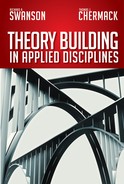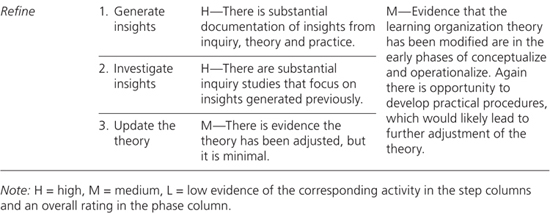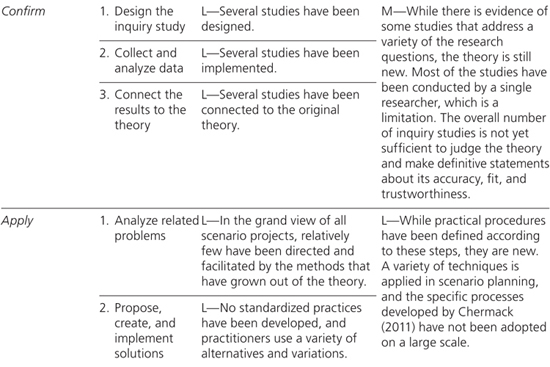11
Figuring Out the Present Status of a Theory
THE BULK OF THIS BOOK has been an effort to detail and illustrate the use of the five-phase General Method of Theory Building in Applied Disciplines. This chapter demonstrates another way of using the method—as a tool for assessing the status of theories. Specifically, this chapter will
• summarize the method’s holistic utility,
• describe how the method can be used to assess theories, and
• illustrate the use of the method to assess applied discipline theories.
Theory building is challenging work. Deep thinking and consistent examination of an integrated set of relationships takes time. Plus, there are many barriers to theory building in applied disciplines. Gaining access to organizations with their fickle short-term financial views and organizational politics are two barriers. In addition, measurement and assessment criteria can provide challenges. Even so, the struggle to arrive at “knowing” something offers inspiration that motivates practitioners and scholars to solve complex problems.
The inability to sustain the needed inspiration and motivation will more likely result in half-baked theories that do not lead to the generation of new knowledge intended. It is unfortunate that scholars dedicate effort to advancing “pieces” of theories that do not connect with their larger context and fall short of holistic description of the selected realm. For sure, practitioners would continue to throw a variety of random solutions in a strict mode of trial-and-error effort, hoping something lands in their personal theory phase buckets: Conceptualize, Operationalize, Confirm, Apply, and Refine. Alternatively, a focus on building robust theories that demonstrate activity in all of the phases—full buckets—will yield more fruitful outcomes.
“Scholars cannot be satisfied with the erroneous idea of theory being disconnected from practice” (Swanson, 2003, p. 209). In applied disciplines, scholars and practitioners have to work together to build robust theories. But if theory is an undefined target that includes personal theories and other forms of uninvestigated opinion, no progress will be made.
To advance the building of robust, useful theories for applied disciplines, all of the phases detailed in this book must be involved in order to legitimately use the term theory. Theorists need to confront the deficiencies that falsely carry the label of “theory based” or some variation. Consultants with personal expertise rushing to sell their simple idea while labeling it a “theory” should be called up short. The scholars in applied disciplines who have not set foot in an organization in several years are just as guilty. Connecting deep thinking with difficult problems should be the hallmark of how applied disciplines move forward. The solution, then, is to apply the general method as a theory assessment tool.
THEORY-BUILDING “BUCKETS”
Our approach to using the General Model of Theory Building in Applied Disciplines as an assessment tool uses a metaphor of a bucket for each theory-building phase. The question to be answered is simply, How full is each “bucket” for the theory being assessed? A generalization from gestalt psychology theory is that “the whole is greater than the sum of its parts.” Even so, the parts are needed to get to the whole, as well as their interactions. And the major concept that frames our presentation of theory building is evident from the synergy that occurs when systems are known and functioning in optimal conditions.
For theory building, the power lies in the robustness of having worked through all the phases and filling each bucket. When each phase is completed rigorously, the outcome not only accurately describes, explains, and in some cases predicts, but is also highly useful in solving problems and changing the way things are done. The consumer task is relatively simple: asking the question “How full is each bucket?”
Figure 11.1 integrates the five phases of theory building into a practical theory assessment tool. To get the most out of the tool, the steps of each phase should be assigned an assessment rating of high, medium, or low. This rating refers to the level of information, evidence, and resources available to support each step. A brief description should also be included, and the same should be done for each full phase overall.
The Conceptualize Bucket
The goal here is simply to assess the extent to which the concepts have been defined, organized, and bounded. A simple rating of high, medium, or low for each step, with brief comments about the nature of the evidence for each step, will suffice. The status of these three steps points to an overall rating for the phase.
The Operationalize Bucket
The Operationalize bucket consists of propositions, results indicators, and research questions. In many ways, these are simple to assess—either they exist or they do not. Another question arises in whether the information found here is comprehensive, but that is really a question left to other phases. Again, ratings should be applied based on information available for each step and integrated into a phase-level rating.
FIGURE 11.1 Theory in Applied Disciplines Status Assessment Tool
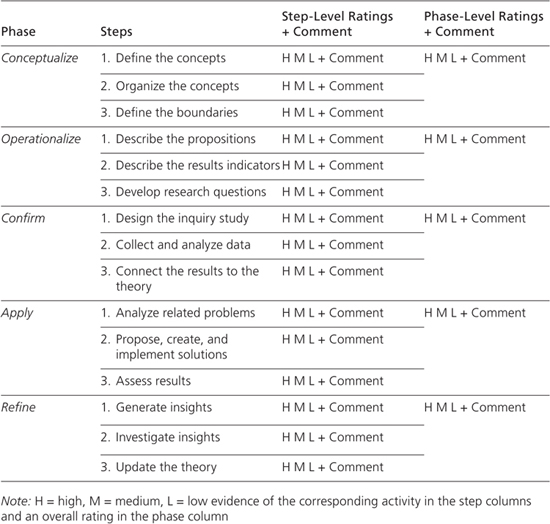
The Confirm Bucket
The Confirm bucket should contain all of the inquiry studies that feature the relationships defined in the theory. These inquiries give an overall sense of the theory’s accuracy, fit in the real world, and trustworthiness. Logically, newer theories will almost always have a low rating here. However, it may come as a surprise that when scrutinized at this level, many theories long held in good standing tend to fall apart.
The Apply Bucket
Documented cases, facilitation guides, procedural manuals, and other practically oriented documents should be sought when considering this phase. These are indicators of a successful translation of a theory into practical procedures that can be implemented in organizations. The documentation of real-world problems, developed solutions, and evidence that the applied theory helps to solve the problems are the desired characteristics of success in this phase.
The Refine Bucket
The Refine bucket is best judged by evidence that the theory was altered and tried again. Such evidence can take the form of more conceptual work, variation from the original Operationalize phase, or modification to any of the other phases. The key is to seek evidence and examples that the theory has been shifted so as to increase its fit with the real world.
The goal is not to quibble over the high, medium, and low scores; rather, it is to gain a perspective of the extent to which each phase was done, whether “excellent” or “needs improvement.” Using this assessment tool requires a degree of familiarity with the realm in which the theory is working. The key task is to search for evidence that each phase has been completed, and then make a judgment as to the significance of the evidence.
Figures 11.2 and 11.3 are two samples of completed applied theory status assessments of the learning organization and scenario-planning case examples in the previous two chapters.
NEXT STEPS FOR THE LEARNING ORGANIZATION CULTURE THEORY BASED ON THE ASSESSMENT
The theory of learning organization culture developed by Mar-sick and Watkins (1999) has a documented history of conceptual development, a substantial track record of research, and evidence of adjustment over time. An area for possible extension is in the Apply phase. Marsick and Watkins might consider developing some practical procedures or frameworks for creating or bolstering learning organization cultures in organizations. The seven dimensions are substantial aspects of organizational life (e.g., team learning, embedded systems, leadership, etc.), and further guidance from the authors and their expertise concerning how to integrate these abstract and often difficult areas would be immensely helpful.
FIGURE 11.2 Learning Organization Theory Status Assessment
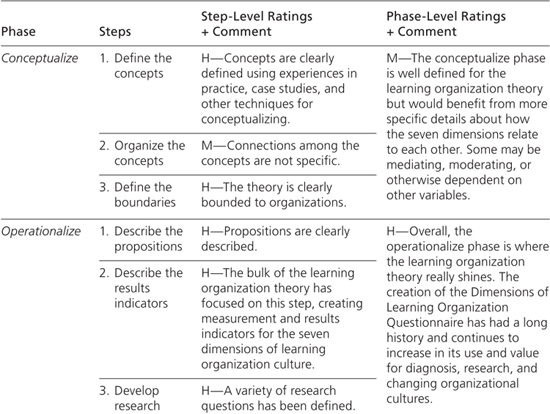
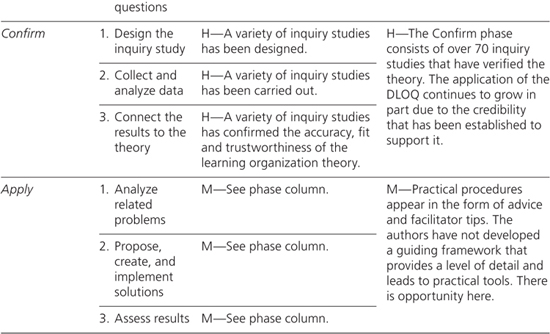
Our own familiarity with learning organization research also indicates an opportunity in studying how the seven dimensions fit together and how the constructs may or may not be related to each other. For example, could “embedded systems” be a moderator of “team learning”? Could “dialogue and inquiry” be a driver of “empowerment”? We believe there is opportunity in examining the interrelations among the theory components.
NEXT STEPS FOR THE SCENARIO-PLANNING THEORY BASED ON THE ASSESSMENT
Based on the judgment used to complete the assessment of the theory, more decisions must be made. Generally, and based on the ratings in Figure 11.3, the weak areas for the theory of scenario planning are confirmation and its application. Opportunity lies in the conduct of further research on scenario planning. Relatively few studies have been conducted that investigate the theory in particular, so key questions will center around how much evidence is enough to judge that the theory is useful and explains some outcomes of the scenario-planning process. How many replication studies are needed on the same topic? The overall status of research on scenario planning (beyond the specific theory) is lacking, and little is generally known about what makes scenario planning succeed or fail, and what its outcomes really are. In addition, developing a set of standard procedures and tools for applying the theory are an obvious area for development. Our familiarity with scenario planning allows a degree of insight into the status of the theory and its use, as well as other scenario-planning practices.
FIGURE 11.3 Scenario-Planning Theory Status Assessment
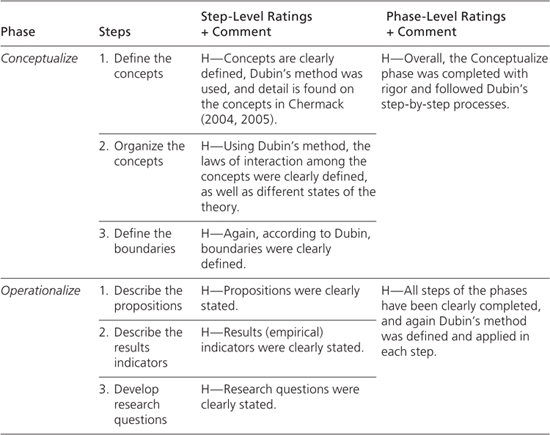
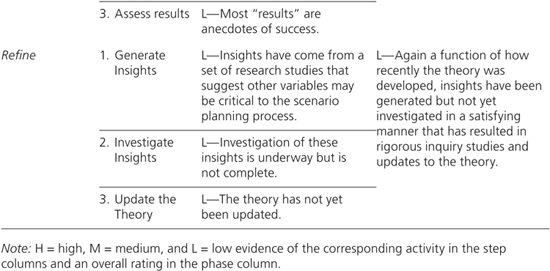
CONCLUSION
While the primary utility of the General Method of Theory Building in Applied Disciplines is to build theories, another use is to figure out the status of an existing theory. The purpose of this chapter was to illustrate how the General Method of Theory Building in Applied Disciplines could be used to assess the overall completeness of a theory. As a prerequisite, we have argued that a higher standard in applied disciplines is necessary as to what counts for theory. Using our approach, we have argued that a theory must meet basic activity in all of the phases of theory building in applied disciplines. The extent of the activity in each phase has implications for a theory’s maturity, but at a basic level, ideas by themselves do not constitute theory. Inquiry studies by themselves do not constitute theory. The development of an assessment instrument by itself does not constitute theory. No, a more rigorous definition of theory is in order.
From our point of view, theories are ideas that have been translated to assessment criteria, confirmed in rigorous inquiry studies, applied in practice, and are subjected to ongoing assessment and examination. Using the general five-phase method of Theory Building in Applied Disciplines to assess the current status of a theory can ensure that a higher standard for what counts as theory is held and that the next efforts to fill the voids can be determined.
